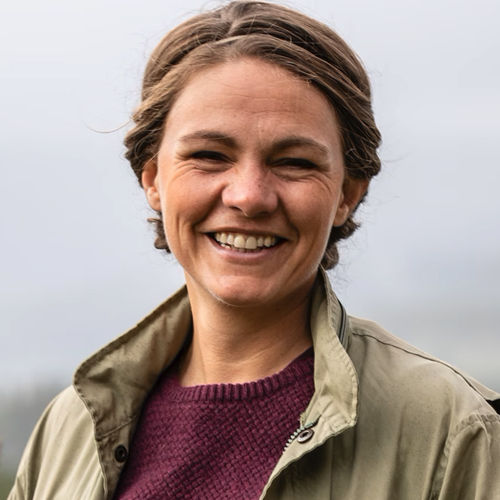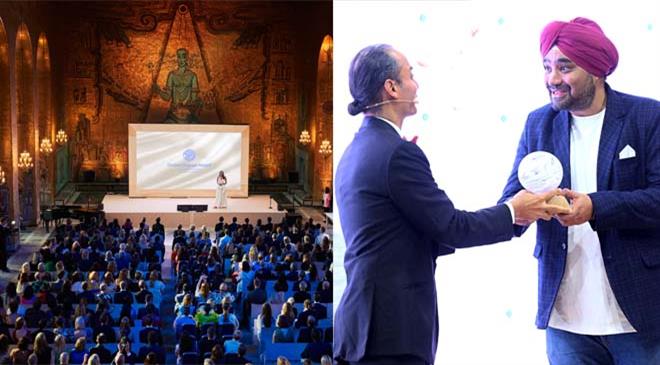
Christiane Dolva
Strategy Lead
H&M Foundation
One of our main priorities will be merging the people and the planet perspectives
H&M Foundation accelerates solutions toward a socially inclusive and planet-positive textile industry. It uses philanthropic resources to fund vital research and breakthrough innovation, develop powerful partnerships and create inspiring storytelling that shifts narratives. In a chat with Fibre2Fashion, the Foundation’s Strategy Lead Christiane Dolva talks about the foundation, the Global Change Award, and sustainability.
Fibre2Fashion: As the H&M Foundation Strategy Lead, what are your primary responsibilities and areas of focus within the organisation?
Christiane Dolva:
I am responsible for setting out the strategic direction for the Planet Positive pillar of H&M Foundation. I work with different kind of partnerships to speed up meaningful research and innovation, and I also connect different actors in the industry to adopt and scale new ways of working that can help transform the industry towards a planet-positive fashion future.
F2F: Can you provide an overview of the H&M Foundation’s mission and its role within H&M’s sustainability efforts?
CD:
H&M Foundation is a separate legal entity from H&M, and it is not at all a part of the company’s sustainability efforts. H&M Foundation is a privately funded non-profit philanthropic organisation. We work to enable a socially inclusive and planet positive textile industry. So far, we have supported game-changing research on new materials, production methods and digital tools for the industry, and disruptive innovations through our innovation challenge—the Global Change Award, where we support entrepreneurs and start-ups with the potential to transform the industry. Several of these have been picked up and are adopted by the industry. We also have larger collective impact initiatives in India and Bangladesh, where we work with inclusive circularity around informal waste pickers in India and equipping women garment workers in Bangladesh for a digital future.
F2F: How does the Global Change Award align with H&M Foundation’s goals and overall vision for a planet positive industry?
CD:
Through the Global Change Award (GCA), our aim is to benefit the entire industry, not specific brands. The idea is to find innovations and methods that can create major change for the entire industry, therefore any brand, supplier or manufacturer is welcome to collaborate with us, and for example, the GCA winners are free to collaborate with whomever they want. Brands connected to H&M Group have been quick in collaborating with us, but other brands such as PVH Corporation, Decathlon, Pangaia, Nike, Converse, Tommy Hilfiger, Calvin Klein and Bestseller have also tested innovations we support and joined some of our projects.
F2F: Can you provide examples of previous Global Change Award winners who have made significant contributions to transforming the fashion industry? How has the H&M Foundation supported these winners beyond the grant funding?
CD:
H&M Foundation launched the GCA to provide the tools, connections, and resources necessary for early-stage innovations to move from idea to scale as quickly as possible. Beyond the €200,000 grant, the winners get to take part of the yearlong GCA Impact Accelerator. The accelerator – provided by H&M Foundation, Accenture, KTH Royal Institute of Technology and The Mills Fabrica – is tailormade to enable accelerated scaling of the winning ideas through business and tech readiness, innovation readiness as well as industry access and investor readiness. It also brings winners a mix of inspiring digital sessions and meet-ups at key locations.
F2F: What made KBCOLS SCIENCES stand out as one of the winners of Global Change Award this year? What aspects of its innovation were particularly impressive?
CD:
We were truly impressed by the innovative approach taken by the KBCOLS SCIENCES team in developing novel microbial dyes, repurposing an existing resource, and addressing the industry’s dye waste challenges. Their achievement of devising a drop-in solution aligns perfectly with the core objectives of the Global Change Award. We aim to equip the industry with ground-breaking innovations that can be readily adopted and scaled, and their work exemplifies this vision.
F2F: According to you, how does the innovation of KBCOLS SCIENCES will help in ensuring the safety and regulatory compliance of bio-fermenting textile dyes in terms of human health and environmental impact?
CD:
The approach of KBCOLS team has the potential to significantly reduce the risk of exposure to harmful chemicals, both for the workers and for the environment. By avoiding the use of carcinogenic chemicals, dyes, salts, and heavy metals, the innovation can prevent pollution of essential water sources. This is in contrast to the traditional dyeing practices, which are known to contribute to freshwater pollution, accounting for almost 20 per cent of such pollution. The discharge from these industries often contains a harmful mixture of chemicals and heavy metals, which not only harm the environment but also have negative impacts on people living in the communities around dyehouses.
F2F: How does the H&M Foundation collaborate with other stakeholders, such as NGOs, industry partners, or academic institutions, to drive sustainable change in the fashion industry?
CD:
Partners and programmes are carefully selected based on our strategy and sought impact. The partners’ perspectives and approach need to match H&M Foundation’s vision. We collaborate with those who can help us realise our vision. We form partnerships with people, organisations, research institutes or brands that advance the industry to become socially inclusive and planet positive. The partners also need to be able to track impact.
F2F: In your opinion, what are the most important actions that the fashion industry should take to achieve greater sustainability and reduce its environmental impact?
CD:
The most important action, and the biggest challenge as well, is speeding up the pace of the transformation. There are obviously a lot of challenges in the industry, and you can’t tackle them one by one. I would say that the whole industry has much better insights and knowledge on how clothes are made, what the key challenges are and how to solve them. But it is not going fast enough and that’s why we as a foundation try to speed up this process, as well as include both the planet and people perspective in this transformation.
F2F: As a sustainability expert, what are some of the emerging trends in the fashion industry that you find particularly exciting or promising?
CD:
There is a lot of momentum in several different areas, and rather than pinpointing one or two emerging trends, I would like to say that the fact that the industry is embracing the complexity and the interconnectedness of all the topics related to sustainability is a “trend” that I find particularly exciting. I deliberately put the word trend in quotation marks because the definition of a trend is something that emerges and then passes, and I hope and believe that the momentum I see in the industry is not a trend but rather a new normal.
F2F: Looking ahead, what are some of the key priorities and focus areas for H&M Foundation’s sustainability strategy, and what impact do you hope to achieve in the future?
CD:
One of our main priorities will be merging the people and the planet perspectives going forward and enabling the industry to move towards inclusive circularity. There are millions of people working in this industry and as the value chains are changing, the industry must look at how the transition to circular models and automation can ensure a just, fair and inclusive approach that can continue to enable livelihood opportunities.

Rahul Mehta
Pradip Mehta
Anurag Batra
Aseem Prakash
Gabi Seligsohn
Bill D’Arienzo
Rahul Mehta
Abhay Gupta
Fanny Vermandel
Arun Sirdeshmukh



_8.JPG)









